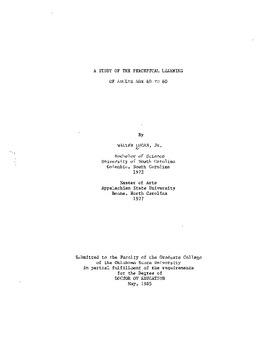| dc.contributor.advisor | Davis, Jerry | |
| dc.contributor.author | Lucas, Walter, Jr. | |
| dc.date.accessioned | 2015-09-11T19:31:42Z | |
| dc.date.available | 2015-09-11T19:31:42Z | |
| dc.date.issued | 1985-05 | |
| dc.identifier.uri | https://hdl.handle.net/11244/17709 | |
| dc.description.abstract | Scope of Study: The objective of this study was to measure and compare the actual and perceived learning styles (print, aural, interactive, visual, haptic, 'kinesthetic, and' olfactory) of prime-year adults aged 40 to 60. The revised Multi-Modal Paired Associates Learning Test (MMPALT II) and the Perceptual Modality Preference Survey (PMPS) were used in conducting the research. The subject population consisted of 10 females and 35 males. The research questions addressed in the study were: (1) Do the seven learning styles manifest themselves in prime-year adult learners? (2) Are there measurable differences in the learning styles of prime-year adults? (3) Are there identifiable patterns of dominant learning styles among prime-year adult learners? (4) Do prime-year adult learners' self-assessments of their perceptual modalities of learning style exhibit positive correlation with their actual learning styles as measured empirically. (5) Are there meaningful differences, by demographic characteristics, in the identifiable patterns of learning styles of prime-year adults? Learning styles of the 45 subjects were evaluated through an analysis of scores and ranks computed from the two measurement instruments. Pearson's correlation coefficient, analysis of variance, and t-tests were used in the data analysis to answer the five research questions. | |
| dc.description.abstract | Findings and Conclusions: The analysis of the learning styles of the sample of prime-year adults indicated that prime-year adults do exhibit all seven learning styles. Differences in the degree of utilization of the seven learning styles were measured and were found to vary considerably among the subjects. Patterns of preferred or dominant learning styles were identified and ranked in order of dominance. It was found that the subjects' perceptions about their learning styles were not positively correlated with their actual or demonstrated learning styles. No meaningful differences were detected in the subjects' learning styles by a variety of demographic characteristics. The findings of the study led to several conclusions and recommendations about the use of the test instruments and avenues for future research. | |
| dc.format | application/pdf | |
| dc.language | en_US | |
| dc.rights | Copyright is held by the author who has granted the Oklahoma State University Library the non-exclusive right to share this material in its institutional repository. Contact Digital Library Services at lib-dls@okstate.edu or 405-744-9161 for the permission policy on the use, reproduction or distribution of this material. | |
| dc.title | Study of the perceptual learning of adults age 40 to 60 | |
| dc.contributor.committeeMember | Baird, John | |
| dc.contributor.committeeMember | Knight, Clyde B. | |
| dc.contributor.committeeMember | Seals, James | |
| osu.filename | Thesis-1985D-L933s.pdf | |
| osu.accesstype | Open Access | |
| dc.type.genre | Dissertation | |
| dc.type.material | Text | |
| thesis.degree.discipline | Occupational and Adult Education | |
| thesis.degree.grantor | Oklahoma State University | |
